Ernest Hemingway's favourite Spanish haunts
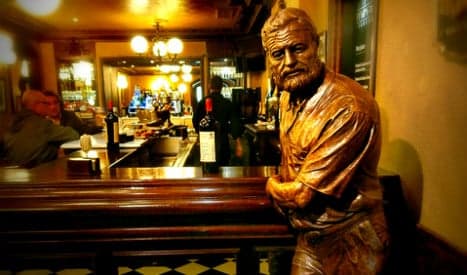
The legendary American writer spent some of his happiest and most productive years in Spain. Here are Hemingway's favourite hang-outs in a country that fascinated and inspired him.
Ernest Hemingway, born on 21st July, 1899, adored the Spanish way of life, particularly Madrid's, the city to which he returned again and again to drink, write and immerse himself in the culture of the bullfight.
Adoring bullfighting also led "Don Ernesto" - as he was christened in Spain - to the northern Spanish city of Pamplona, home of the San Fermín running of the bulls festival which he made famous in his 1926 novel Fiesta: The Sun Also Rises.
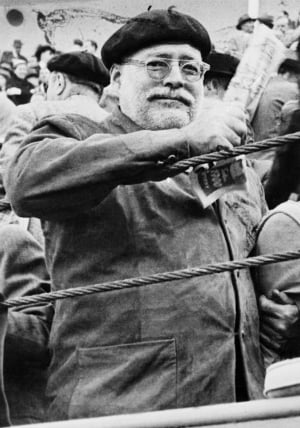
Hemingway at a bullfight in Pamplona. Photo: AFP
One of the most iconic writers in American literature would set several of his novels and short stories in Spain and return to the country dozens of times from the 1920s, throughout the 1930s when he covered the Civil War, up to his final visit in 1960.
But where did Hemingway visit when he came to his beloved Spain? The Local gives you a rundown of some of his favourite haunts.
Museo Chicote (Gran Vía 12, Madrid)
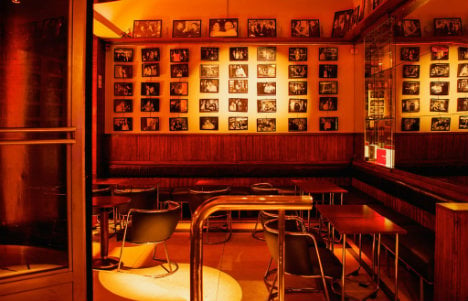
Museo Chicote, Madrid. Photo: grupomercardodelareina.com
Stepping through the revolving door of this cocktail bar, on Madrid’s Gran Vía, is like stepping back into a bygone era, when Hemingway would socialize with other journalists in the city, or when the likes of Frank Sinatra and Ava Gardener would sip on martinis in one of Chicote’s booths. The bar features in Hemingway’s short story, The Denunciation.
Cervecería Alemana (Plaza Santa Ana 6, Madrid)
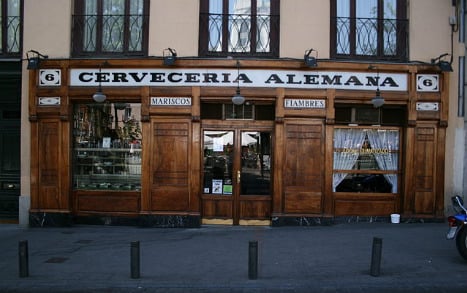
Photo: Tamlorlan/Wikimedia
This German beerhouse was a firm favourite of Hemingway’s, so much so, he even had his own table by the door. He called it one of his favourite bars in Madrid, whether he fancied a coffee or a beer.
Restaurante Botín (Calle Cuchilleros 17, Madrid)
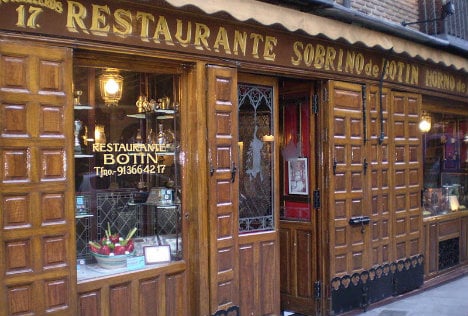
Photo: Esetena/Wikimedia
The oldest restaurant in the world, Botín - just a few steps from Madrid’s Plaza Mayor - was one of Hemingway’s favourite hangouts.
He was friends with the owners, who let him write upstairs before meeting friends for lunch, usually the house speciality - roast suckling pig. Hemingway loved Botín so much he set the final scene of The Sun Also Rises in the restaurant.
Las Ventas bullring
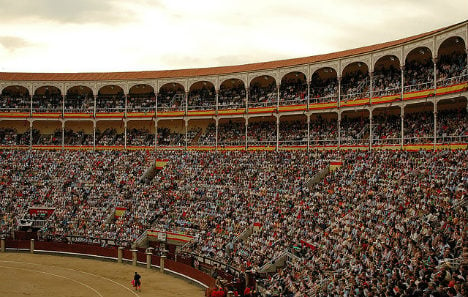
Photo: Eneique Dans/Flickr
Hemingway was a regular at Las Ventas when he was in Madrid, especially to watch his friends, the bullfighters Luis Miguel Dominguín and Antonio Ordóñez.
Matadero slaughter house
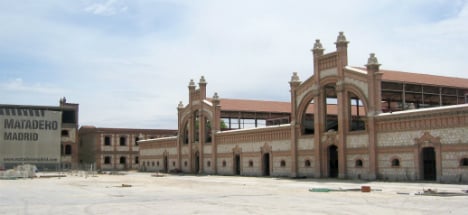
Madrid's former slaughterhouse, now a cultural centre. Photo: AlesKubr2/Wikimedia
The Matadero, along the Manzanares River is nowadays a modern gallery and performance space, but back when Hemingway was in Madrid, it was home to the city’s abattoir. Legend has it the writer would rise early and visit the slaughterhouse to watch the novilleros, or novice bullfighters, practice killing.
La Venencia (Calle Echegaray 7, Madrid)
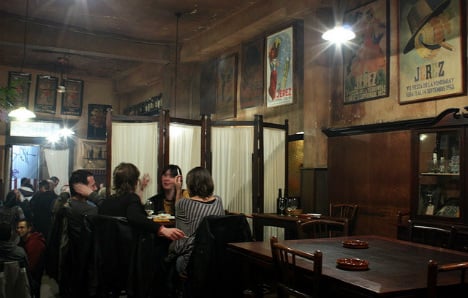
Photo: Krista/Flickr
Today the decor of this central Madrid sherry bar is much the same as it was in Hemingway’s day, with its old wooden barrels and sawdust floor when he would pitch up for a glass of sherry.
Palace Hotel
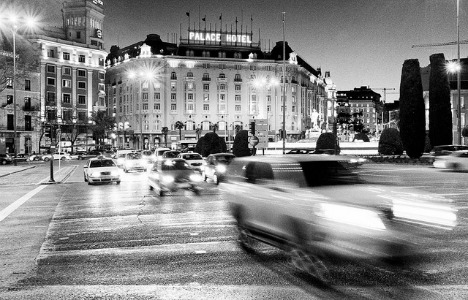
Photo: Claus Gerull/Flickr
Hemingway would stay here (now the Westin Palace Hotel), as well as at the Hotel Gran Vía (now the Tryp Gran Vía) when he was visiting Madrid. He could often be found in the bar of the Palace Hotel, enjoying a Martini before visiting the Prado museum, just around the corner.
Café Iruña, Pamplona
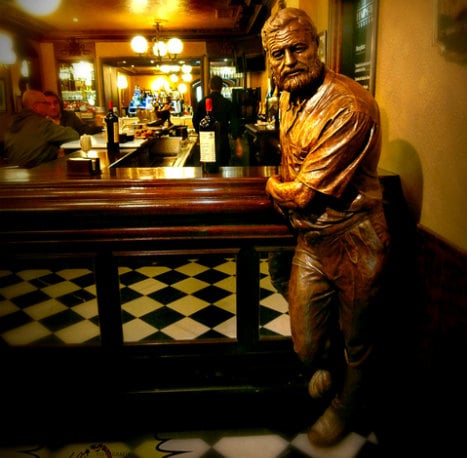
Hemingway propping up the bar at Cafe Iruña in Pamplona. Photo: dlmanrg/Flickr
When visiting the running of the bulls fiesta in Pamplona, Hemingway would often relax in the Café Iruña, an elegant watering hole that today, has a "Hemingway corner" complete with a bronze lifesize statue of the writer, which attracts visitors from all over the world who come to share a tipple with one of the most famous drinkers of the 20th century.
Comments
See Also
Ernest Hemingway, born on 21st July, 1899, adored the Spanish way of life, particularly Madrid's, the city to which he returned again and again to drink, write and immerse himself in the culture of the bullfight.
Adoring bullfighting also led "Don Ernesto" - as he was christened in Spain - to the northern Spanish city of Pamplona, home of the San Fermín running of the bulls festival which he made famous in his 1926 novel Fiesta: The Sun Also Rises.

Hemingway at a bullfight in Pamplona. Photo: AFP
One of the most iconic writers in American literature would set several of his novels and short stories in Spain and return to the country dozens of times from the 1920s, throughout the 1930s when he covered the Civil War, up to his final visit in 1960.
But where did Hemingway visit when he came to his beloved Spain? The Local gives you a rundown of some of his favourite haunts.
Museo Chicote (Gran Vía 12, Madrid)

Museo Chicote, Madrid. Photo: grupomercardodelareina.com
Stepping through the revolving door of this cocktail bar, on Madrid’s Gran Vía, is like stepping back into a bygone era, when Hemingway would socialize with other journalists in the city, or when the likes of Frank Sinatra and Ava Gardener would sip on martinis in one of Chicote’s booths. The bar features in Hemingway’s short story, The Denunciation.
Cervecería Alemana (Plaza Santa Ana 6, Madrid)

Photo: Tamlorlan/Wikimedia
This German beerhouse was a firm favourite of Hemingway’s, so much so, he even had his own table by the door. He called it one of his favourite bars in Madrid, whether he fancied a coffee or a beer.
Restaurante Botín (Calle Cuchilleros 17, Madrid)
Photo: Esetena/Wikimedia
The oldest restaurant in the world, Botín - just a few steps from Madrid’s Plaza Mayor - was one of Hemingway’s favourite hangouts.
He was friends with the owners, who let him write upstairs before meeting friends for lunch, usually the house speciality - roast suckling pig. Hemingway loved Botín so much he set the final scene of The Sun Also Rises in the restaurant.
Las Ventas bullring

Photo: Eneique Dans/Flickr
Hemingway was a regular at Las Ventas when he was in Madrid, especially to watch his friends, the bullfighters Luis Miguel Dominguín and Antonio Ordóñez.
Matadero slaughter house

Madrid's former slaughterhouse, now a cultural centre. Photo: AlesKubr2/Wikimedia
The Matadero, along the Manzanares River is nowadays a modern gallery and performance space, but back when Hemingway was in Madrid, it was home to the city’s abattoir. Legend has it the writer would rise early and visit the slaughterhouse to watch the novilleros, or novice bullfighters, practice killing.
La Venencia (Calle Echegaray 7, Madrid)

Photo: Krista/Flickr
Today the decor of this central Madrid sherry bar is much the same as it was in Hemingway’s day, with its old wooden barrels and sawdust floor when he would pitch up for a glass of sherry.
Palace Hotel

Photo: Claus Gerull/Flickr
Hemingway would stay here (now the Westin Palace Hotel), as well as at the Hotel Gran Vía (now the Tryp Gran Vía) when he was visiting Madrid. He could often be found in the bar of the Palace Hotel, enjoying a Martini before visiting the Prado museum, just around the corner.
Café Iruña, Pamplona

Hemingway propping up the bar at Cafe Iruña in Pamplona. Photo: dlmanrg/Flickr
When visiting the running of the bulls fiesta in Pamplona, Hemingway would often relax in the Café Iruña, an elegant watering hole that today, has a "Hemingway corner" complete with a bronze lifesize statue of the writer, which attracts visitors from all over the world who come to share a tipple with one of the most famous drinkers of the 20th century.
Join the conversation in our comments section below. Share your own views and experience and if you have a question or suggestion for our journalists then email us at [email protected].
Please keep comments civil, constructive and on topic – and make sure to read our terms of use before getting involved.
Please log in here to leave a comment.